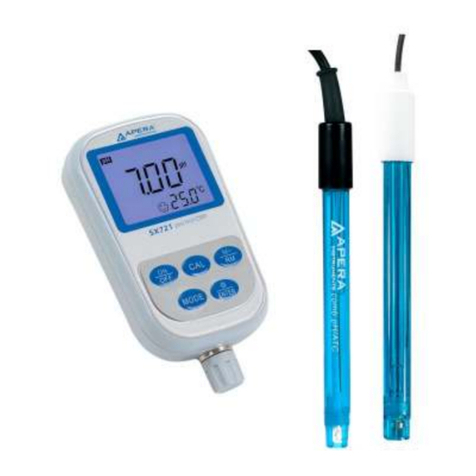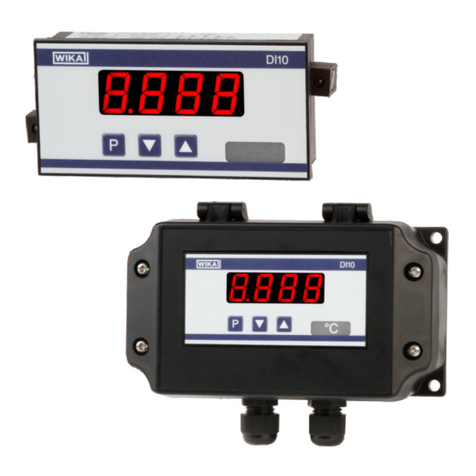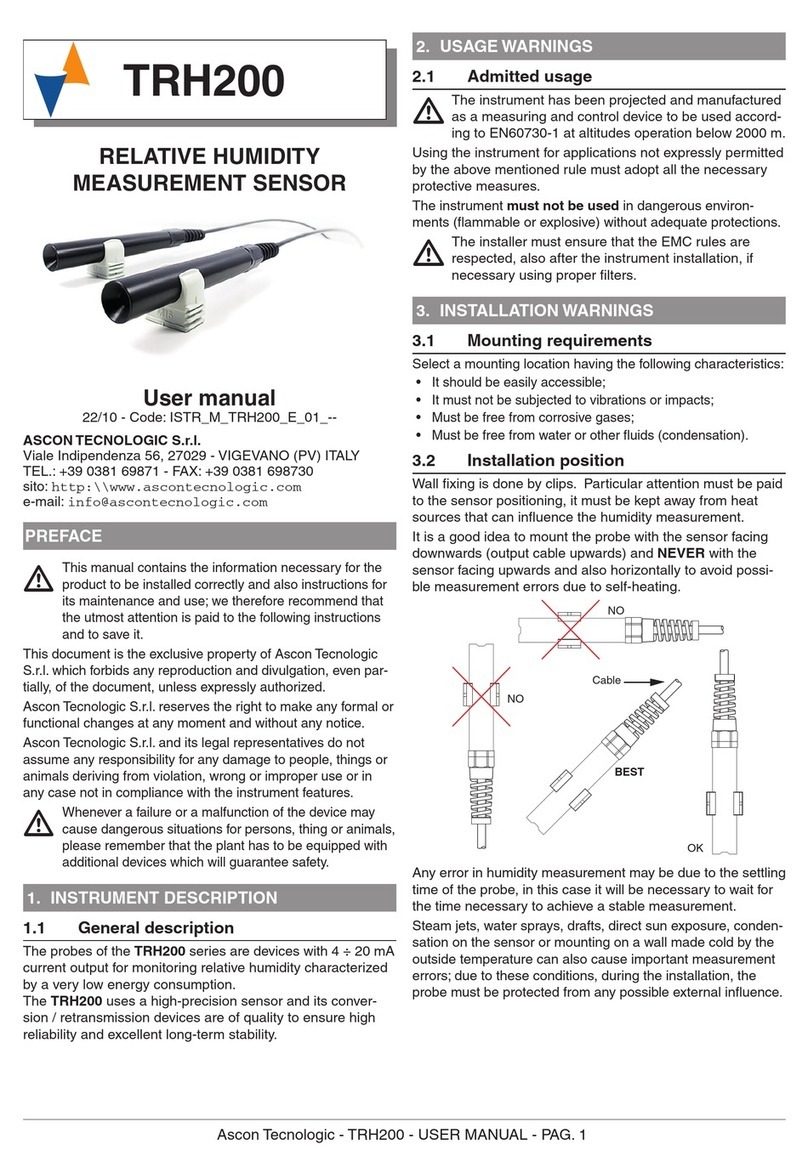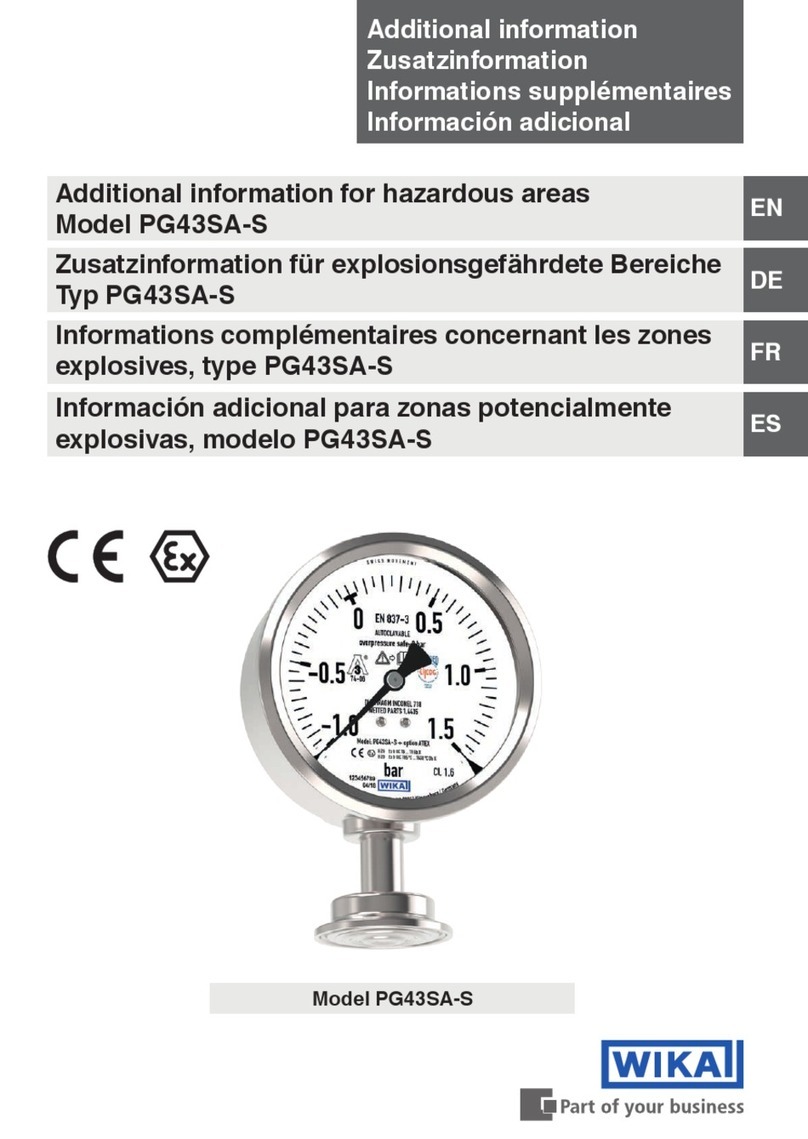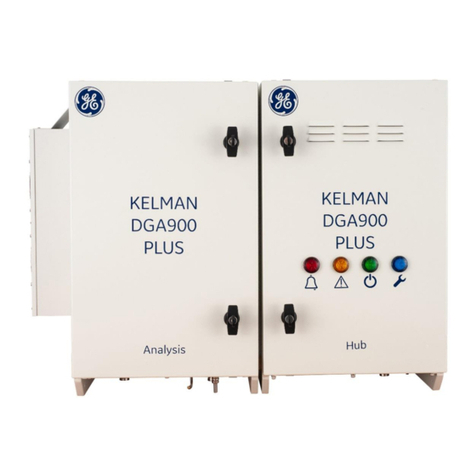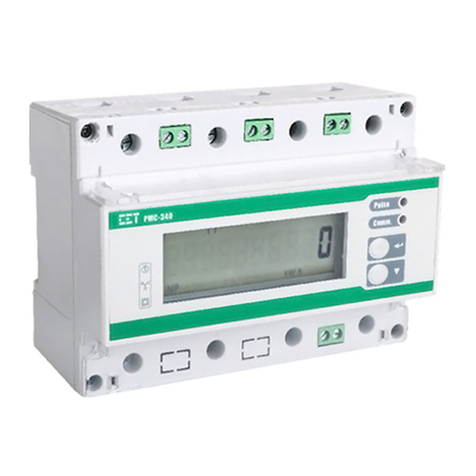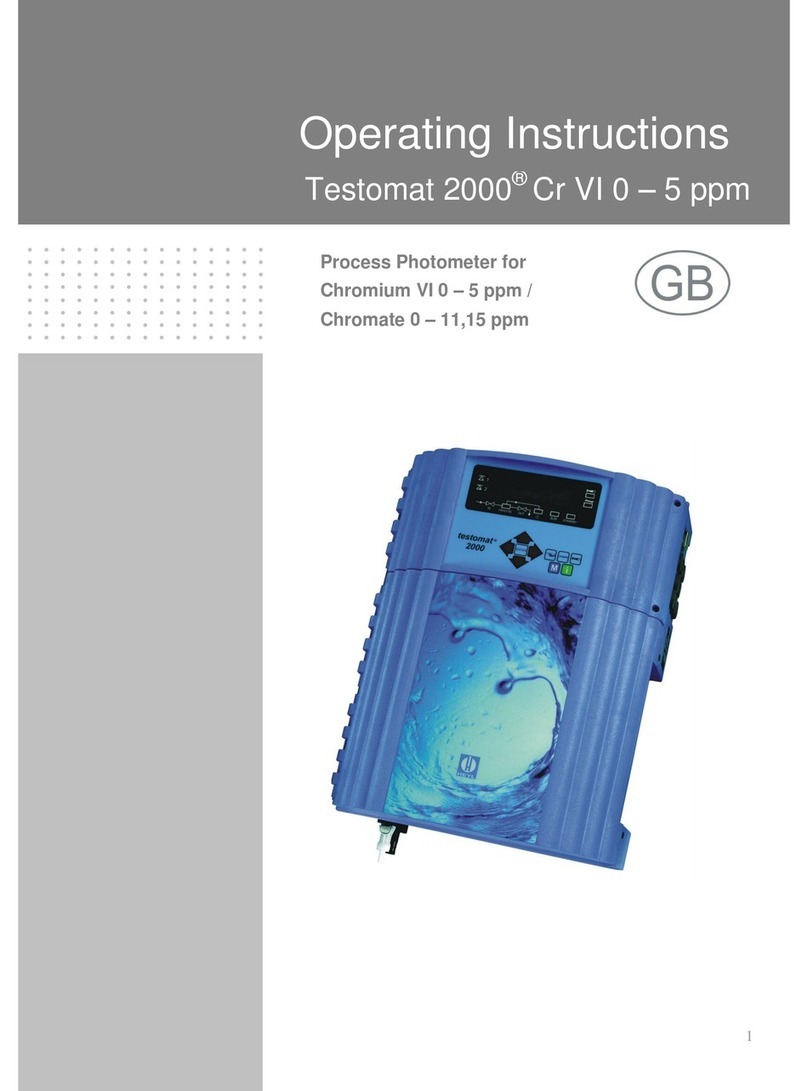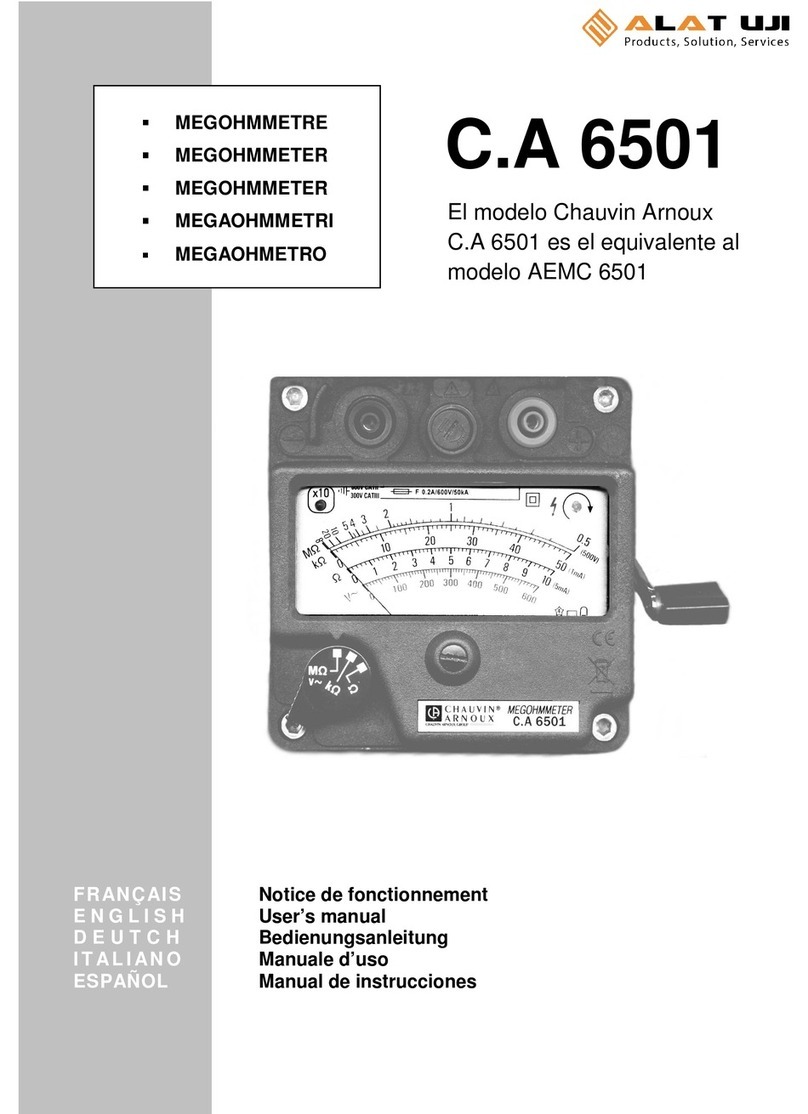Transcell Technology TI-1500 Parts list manual

DigitalWeightIndicator
Setup/OperationManual
Revision 1.7
1
February
25
, 2009

i
TABLE OF CONTENTS
Page
INTRODUCTION
...........................................................................................................................................................
1
FCC NOTE
....................................................................................................................................................................
1
INSTALLATION
.............................................................................................................................................................
2
PREPARATION
.........................................................................................................................................................
2
CONNECTIONS
........................................................................................................................................................
2
CONNECTING THE WEIGH PLATFORM
.................................................................................................................
3
CONNECTING THE SERIAL I/O DEVICE
................................................................................................................
3
CONFIGURATION
........................................................................................................................................................
4
OVERVIEW
...............................................................................................................................................................
4
ACCESSING THE MENUS
.......................................................................................................................................
4
MENU STRUCTURE
.................................................................................................................................................
5
SETUP MENU DESCRIPTIONS
...............................................................................................................................
5
SETUP MENU PROCEDURES
................................................................................................................................
.7
USER
MENU DESCRIPTIONS
................................................................................................................................
.8
USER MENU PROCEDURES
...................................................................................................................................
9
EXITING THE MENUS
............................................................................................................................................
10
CALIBRATION
............................................................................................................................................................
11
CALIBRATION OVERVIEW
....................................................................................................................................
11
ZERO CALIBRATION (F16)
....................................................................................................................................
11
SPAN CALIBRATION (F17)
....................................................................................................................................
11
VIEW CALIBRATION VALUES (F18)
......................................................................................................................
12
KEY
-
IN ZERO CALIBRATION VALUE (F19)
..........................................................................................................
13
KEY
-
IN SPAN CALIBRATION VALUE (F20)
...........................................................................................................
13
OPERATION
...............................................................................................................................................................
14
DISPLAY
................................................................................................................................................................
.
14
KEYBOARD
.............................................................................................................................................................
14
FUNCTION KEYS
...............................................................................................................................................
15
GENERAL SCALE OPERATION
.............................................................................................................................
15
WEIGHING AN ITEM
..........................................................................................................................................
15
PIECE COUNTING MODE
..................................................................................................................................
15
PEAK HOLD MODE
............................................................................................................................................
16
REMOTE DISPLAY MODE
................................................................................................................................
.
16
LEGAL FOR TRADE SEALING
...................................................................................................................................
17
APPENDIX A: SPECIFICATIONS
...............................................................................................................................
18
APPENDIX B:
SERIAL PORT INFORMAT
ION
...........................................................................................................
19
SERIAL PORT MODES
...........................................................................................................................................
19
DEMAND DUPLEX M
ODE
..................................................................................................................................
19
CONTINUOUS DUPLEX MODE
.........................................................................................................................
19
AUTO PRINT MODE
...........................................................................................................................................
19
OUTPUT STRIN
G
...................................................................................................................................................
20
TEXT PRINT TICKET
..........................................................................................................................................
21
STRING FORMAT 1 (Condec Demand String)
...................................................................................................
22
STRING FORMAT 2 (Condec Continuous String)
...............................................................................................
23
APPENDIX C: DISPLAYED ERROR CODES
.............................................................................................................
25
©Transcell Technology, Inc. 200
9
. All rights reserved.
The information
contained herein is the property of Transcell Technology and is supplied without liability for errors or omissions. No
part may be reproduced or used except as authorized by contract or other written permission. The cop
y
right and the foregoing
restriction
on reproduction and use extend to all media in which the information may be embo
d
ied.
Contents subject to change without notice.
975 Deerfield Parkway Buffalo Grove, IL 60089
Tel (847) 419-
9180 Fax (847) 419
-
1515
http://www.transcell.com

1
INTRODUCT
ION
The
TI
-1500 Series Digital Indicator is a general purpose, industrial grade weight indicator. Two models
are currently available, distinguishable by display type, enclosure type and power supply. Table 1 shows
the
TI
-
1500 Series
product m
a
trix.
All models operate identically, can readout up to 50,000 display divisions and can supply enough current
for up to 8-
350
load cells. All setup parameters may be entered via the front panel keys, including
calibr
a
tion.
If your Model
TI
-
15
00 Series Digital Indicator is part of a complete floor scale or has
already
been
installed for you, you may skip to
the
operating instructions. Prior to using the indicator, please read this
chapter carefully and completely. Store the manual in a safe and convenient place so it will be available
if you have questions concerning the oper
a
tion of the scale.
MODEL
DISPLAY
TYPE
ENCLOSURE
TYPE
POWER SOURCE
TI
-
1500
LED
ABS
100
-
240 VAC, 50/60 Hz 30W
TI
-
1520
LED
Stainless Steel
100
-
240
VAC, 50/60 Hz
30W
TAB
LE 1: TI
-
1500
Series Product Matrix
FCC
NOTE
This equipment has been tested and found to comply with the limits for a Class A digital device, pursuant
to Subpart J of Part 15 of the FCC Rules. These limits are designed to provide reasonable protecti
on
against harmful interference when the equipment is operated in a commercial environment. This
equi
pment generates, uses and can radiate radio frequency energy and, if not installed and used in
accordance with the instructions manual, may cause harmful interference to radio com
munications.
Operation of this equipment in a residential area is likely to cause harmful interference in which case the
user will be required to correct the interference at his/her own e
x
pense.

2
INSTALLATION
PREPARATION
Any pre
cision instrument requires a suitable environment in which to operate as intended. Please review
each of
the following
prior to installation:
Electrical Power
The
TI
-
1500
indicators
have been designed to operate from
100
to
240
VAC at 50/60 Hz.
All
units ship
with the appropriate power plug for its area of intended use.
To avoid electrical noise interference
and/or stray AC electrical transients
, try to operate the indicator
from a circuit
separate
from any equipment containing
inductive devices such a
s a contactor coil,
solenoid, relay coil, or motor
.
Be sure to
use shielded cables for the load cell connections (ground shield
wire at indicator) and run these cables away from
your
AC/DC power cables
if possible
.
In extreme cases, it may be necessary t
o
install
surge suppressors, line conditioners or even UPS
(
Uninterruptible Power Supplies
)
systems
(not included)
.
Environment
-
Avoid installing the
indicator
in areas of direct sunlight
or
high humidity
-
Avoid sudden temperature change
–
if this is unavo
idable allow equipment to ‘soak’ at a constant
temperature for at least three hours before use
-
Ensure that steady, clean AC power
is available to the unit
Remember that the installer is ultimately responsible to assure that a particular
installation will
be and remain safe and operable under the specific conditions
encountered.
CONNECTI
ONS
For the
TI
-
1500
model, the rear panel contains all connectors necessary to make the appropriate
connections to the weigh platform, printer, remote display and power su
pply.
DC Jack
Serial
Port
LOAD CELL
Setup/Calibration Switch
Port
For the TI
-
1520
Plus model, the rear cover must first be removed to make the appropriate connections to
the weigh platform, printer, remote display and power supply. To remove the rear cover, simply remove
the scr
ews that secure it to the enclosure and set aside.
Caution!
Disconnect power source from indicator prior to removing rear cover.

3
CONNECTING THE WEIGH PLATFORM
The
TI
-
1500
model
ships with a 15 ft shielded load cell cable for connection to weigh platform
’s load
cell(s) or junction box.
1.
Plug the cable’s 14-
pin
parallel interface
connector into the load cell port on the rear
panel of the indicator.
2.
Wire the bare wires and shield to the weigh platform’s load cell(s) or junction box using
the color codes s
hown
below
.
4-
wire cable
Optional 6
-
wire cable
Color
Wire Name
Color
Wire Name
Red
+ Excitation
Red
+Excitation
Black
-
Excitation
Black
-
Excitation
Green
+ Signal
Green
+Signal
White
-
Signal
Yellow
-
Signal
Orange
+ Sense
Brown
-
Se
nse
The
TI
-
1520
indicator contains a connection terminal on the main board for connection to the load cell
cable.
Connect your shielded load cell cable (not included) to the appropriate terminal on the main board.
NOTE
: 6
-
wire connection is optional.
Load Cell Connector J4
Pin No.
Wire Name
Pin No.
Wire Name
1
+ Excitation
5
+ Signal
2
+ Sense
6 -
Signal
3 -
Excitation
7
Shield
4 -
Sense
CONNECTING THE SERIAL
I/O DEVICE
The
TI
-
1500
model comes standard with one full duplex RS
-
232 serial
port, designed for connection to a
computer
or a serial printer. The same port may be also used as a simplex, RS
-
232 port designed for
connection to a remote display.
DSUB9 Connector
Pin No.
Wire Name
Pin No.
Wire Name
2
RXD
7 RTS
3 TXD 8 CTS
5
Gr
ound
Connection assignments for all serial
RS
-232
communication terminals
on the
TI
-
1520
are shown
below
.
RS
-
232 Connector J3
Pin No.
Wire Name
Pin No.
Wire Name
1 TXD 4 CTS
2
RXD
5
Ground
3 RTS

4
CONFIGURATION
OVERVIEW
The indicator co
ntains two main
configuration
menus:
The Setup (“F”) menu, which configures the ind
ic
ator to your weigh platform
T
he User (“A”) menu, which configures the serial communication port and enab
les some user
options
The Setup and User menus consist of several
menu sele
c
tions, each
with its own sub
-
menu of selections
or programming procedures
.
To
configure the indicator you must first enter the appropriate menu mode.
Once there, four of the front panel keys become directional navigators to move around in the me
nus, and
one key is used to save or SET the selections
.
ACCESSING THE MENUS
To access the Setup (“F) menu:
1.
Power off the indicator.
2.
Locate the slide switch on the rear cover and move it to
the
opposite position
.
NOTE:
A metal plate held on by two drilled
-
head screws may conceal the slide switch.
3.
Power on the indicator.
The
display
shows ” F 1” to indicate that you are in Setup Menu mode.
4.
Use the navigation keys shown in the
f
igure below
to move
through the menu.
To access the User (“A) menu:
1.
Enter the
Setup (“F”) menu.
2.
Use the right or left directional keys shown
below
to move right or left in the Setup (“F”) menu
until the indicator shows ” A 1”.
SETUP MODE KEY FUNCTIONS
ZERO
GROSS
NET
TARE
PRINT
SET
UNITS

5
MENU STRUCTURE
All menus
consist of a top level
(heading)
and a
secondary level. The top level contains the code (e.g. F1)
for the parameter to be configured. The secondary level contains the selection list or allows access to a
programming sequence.
Use the directional keys to move around in the Menu
Structure
shown
below
.
F1
Grads
10
80
F2
Sampling
Numeric Entry
Etc.
1.
To move to a new heading, use the TARE (left) or PRINT (right) key to move right or left in
the
Menu.
2.
To move to the selection
or programming
level, press the ZERO (down) key once. The
current
ly
saved selection is shown.
3.
To view the available selections for the current heading, use the TARE (left) or PRINT
(right) key to move through the selection field.
4.
To save a new selection, press the NET/GROSS (Set) key .To exit without saving, press
the UNITS (up) key to return
to the current heading.
5.
Repeat Steps 2 through 5 until the Menu is programmed.
SETUP MENU DESCRIPTIONS
This section provides more detailed descriptions of the selections found in the Setup Menu Chart.
Factory
-
set defaults are shown in bold;
(NA)
for
North America and
(€)
for Europe.
NOTE
: Some selections are subject to local legal metrology regulations
CODE/NAME
DESCRIPTION
SELECTION LIST
F1
Graduations
Specifies number of full-scale graduations, i.e. capacity / divi
sion.
Value should be consistent with legal regulations and environmental
li
mits on the useful system resolution. Pressing the
ZERO
key to
scroll down one level begins the s
e
quence
Key
-
in
100
-
50000
10
000 (NA)
6
000 (
€)
F2
Sampling Rate
Sets the sampling rate in Hertz (measurements per second). Use
10 Hz for most applications or 80 Hz for extra fast response time
10 (NA/
€)
80
F3
Zero Track
Band
Selects the range within which the scale will automatically zero. Note
that the scale must be in standstill to automatically zero. Se
lectio
ns
are in display divisions (d).
0d
0.5d (NA/
€)
1d
3d
5d
F4
Zero Range
Selects the range (expressed as a percentage of full scale capacity)
within which the scale may be ze
roed. Note that the indicator must be
in standstill to zero the scale.
100% (NA)
1.
9%
2%
(
€)
20%

6
CODE/NAME
DESCRIPTION
SELECTION LIST
F5
Motion Band
Sets the level at which motion is detected. If motion is not detected,
the scale can process a Print or Zero command. Maximum value
varies depending on local regulations. Expressed as scale divisions
per second (d/s). Pressing the
ZERO
key to scroll down one level
begins the s
e
quence
Key
-
in
0.0d/s
–
32.0d/s
1.0d/s (NA/
€)
F6
Digital Filter
Averages weight readings to produce higher stability. Choose the
speed that works best for your
application.
“FAST” = Fast “nnEd” = Medium “SLo” = Slow
FAST
nnEd
(NA/
€)
SLo
F7
Overload Limit
Selects the desired formula which determines the point at which the
indicator shows overload. All selections are based on the primary unit
selected in F8.
"FS" = Full scale capacity.
FS
FS + 2% (NA)
FS + 5%
FS + 1d
FS + 9d
(
€)
F8
Calib. Unit
Selects the primary base unit to be used in the calibration process.
Also the default unit for normal operation.
"1" = primary unit is lb.
"2" = primary unit is in kg.
1 (NA)
2
(
€)
F9
Display
Divisions
Determines the desired weight increments. Value should be
consi
s
tent with legal requirements.
1
(NA)
2
5
(
€)
F10
Decimal Pt.
Determines location of the decimal point.
0 (N
A)
0.0
(
€)
0.00 0.000
0.0000 00
F14
Units
Conve
r
sion
Allows the lb/kg key to be disabled so that an operator cannot
acc
i
dentally press the key and change the displayed units.
"0" = Disable the Units key "1" = Enable the Un
its key
0
(
€)
1 (NA)
F16
Zero
Calibr
a
tion
Places indicator into the zero calibration routine. Scrolling down with
the ZERO key one level begins the procedure.
Press
ZERO
key
to begin sequence
F17
Span
Calibr
a
tio
n
Places indicator into the span calibration routine. Scrolling down with
the ZERO key one level begins the procedure.
Press
ZERO
key
to begin sequence
F18
View
Calibr
a
tion
Actuates the function that allows you to view both the zero and span
calibration value. The values displayed in this function are valid only
after Calibration (F16 & F17) has been successfully completed.
Scrolling down with the ZERO key one level begins the pro
cedure.
Multi
-
point cal
Press
ZERO
key
to begin sequence
F19
Key
-
in Zero
Allows you to key-in known zero calibration value in case of memory
loss in the field. Scrolling down with the ZERO key one level begins
the procedure.
Press
ZERO
key
to begin sequence
F20
Key
-
in Span
Allows you to key-in a known span calibration value in case of
mem
ory loss in the field. Scrolling down with the ZERO key one level
be
gins the procedure.
Press
ZERO
key
to begin sequence

7
CODE/NAME
DESCRIPTION
SELECTION LIST
F21
Factory Reset
North Ame
r
ica
This sub
-
menu will reset all parameters in the “F” and “A” menu to the
default settings for Nor
th America. USE WITH CAUTION!
Press the
ZERO
key twice to
ex
e
cute
.
F22
Factory Reset
Europe
This sub
-
menu will reset all parameters in the “F” and “A” menu to the
default settings for Europe. USE WITH CAUTION!
Press the
ZERO
key twice to
ex
e
cute.
F23
Fin
e Tune
4-
20 mA
Actuates the function that allows you to fine-tune the optional
4-20 mA analog output. Pressing the ZERO key to scroll down one
level begins the s
e
quence.
Press the
ZERO
key
to begin
sequence
F30
Special
Appl
i
cation
Used to select one special application feature, subject to local
legal
requirements
.
“0” = None (Gross/Net), “2” = Remote Display, “3” = Piece Count,
“5” =
Peak
Hold
0
(NA/
€)
2
3
5
F31
Gross Zero
Band
Selects the range within which the scale will
automatically
clear the
tare and switch to Gross mode. Note that the scale must be in
standstill. Selections are in display divisions (d). Scrolling down with
the
ZERO
key one level b
e
gins the procedure.
“0” =
Disabled
Key
-
in
0
-
10
0 (NA)
10 (
€)
F32
Center of Zero
B
and
Selects the range around gross zero within which the scale will
di
splay the Center of Zero annunciator. Selections are in display
div
i
sions (d).
0
.25d (US
)
0.5d (
€)
F34
Auto Print Min.
Weight
Selects the minimum weight at which the auto print function will work
if enabled. Selections are in display divisions (d). Scrolling down with
the
ZERO
key one level b
e
gins the procedure.
“0” =
Disabled
Key
-
in
0
-
100
1 (NA/
€)
SETUP MENU PROCEDURES
This section provides instructions for all of the Setup Menu procedures except F16 through F20
whose
procedures
can be found in
the Calibration section
.
Fine
-
tune
Optional
4-
20 mA output (F23)
1.
While in the Setup Menu mode, scroll to "F 23", then scroll down once using the ZERO key to
enter Fine
-
tune menu. The
indicator outputs 4 mA and displays a number.
2.
While monitoring the voltage across R
L
(see Appendix E), use the right (PRINT) or left
(TARE) keys to change the displayed value until the measured voltage is exactly 1 VDC.
3.
Press the SET (Net/Gross) key to save. The indicator outputs 20 mA and displays another
number.
4.
While monitoring the voltage across RL, use the right (PRINT) or left (TARE) keys to change
the displayed value until the measured voltage is exactly 5 VDC.
5.
Press the SET (Net/Gross) key to save and revert back to F23.

8
USER
MENU DESCRIPTIONS
This section provides more detailed descriptions of the selections found in the User Menu Chart.
Factory
-
set defaults are shown in bold;
(NA)
for North America and
(€)
for Europe.
CODE/NAME
DESCRIPTION
SELECTION LIST
A1
Baud Rate
Selects the baud rate for data transmission through the serial port.
300, 600, 1200,
2400, 4800,
9600
(NA/
€)
,
19200, 3
8400
A2
Data Bits
and
Parity
Selects the number of data bits and pari
ty of serial transmission.
"8n" = 8 data bits with no parity bit and one stop bit
"7O" = 7 data bits with odd parity bit and one stop bit
"7E" = 7 data bits with even parity bit and one stop bit
"7n" = 7 data bits with no parity bit and two stop bits
8n
(N
A/
€)
7O
7E
7n
A3
Serial Port
Mode
Selects the mode of the
I/O
serial port: Refer to Appendix B for more
information.
"d
" =
Demand Duplex
"C
" =
Continuous Duplex
"
Auto
" =
Auto
Prin
t
d
(NA/
€)
C
Auto
A4
Diagnostics
Actuates the function that illuminates all digit segments, decimal
points, and L
E
D annunciators in a test sequence.
Press
ZERO
key
to begin sequence
A6
Output String
Loads in a pre-
defined
output string (print format)
for
the
serial port.
Refer to Appendix B for details.
"0
" =
Text Print Ticket
"1" =
String Format 1 (
Condec Demand
)
"2
" =
String Format
2
(
Condec Continuous
)
0
(NA/
€)
1
2
A8
ID No. Entry
Actuates the function that allows entry of a new ID No. Pressing the
ZERO
key to scroll down one level begins the sequence.
0
–
999999
99
(NA/
€)
A
14
Time Format
Selects the printed format for time..
"0" = AM/PM "1" = 24 Hr
0
(NA
)
1
(
€)
A1
5
Set
Time
Actuates the function that allows
setting
the time. Pressing the ZERO
key to scroll down one level begins the test sequence.
Press
ZERO
key
to begin sequence
A16
Set Date
Actuates the function that allows setting of the date. Pressing the
ZERO
key to scroll down one level begins the test sequence.
Press
ZERO
key
to begin
sequence
A1
7
Date Format
Selects the printed format for date.
"1
" = mm/dd/yy "
2
" = dd/mm/
20
yy
“3” =
dd/mm/yy
"4" =
dd
/
mm
/
20
yy "5" =
yy
/mm/
dd
“6” =
20
yy/mm/dd
1
(NA
)
2
3
(
€)
4
5 6
A31
Edit
Output
String
Actuates the function that
allows editing of output string
. Pressing the
ZERO
key to scroll down one level begins the test sequence.
Press
ZERO
key
to begin sequence
A34
Decimal
Point
Selects printed
(not displayed)
decimal point character
.
"0
" =
Period (‘.’)
"1
" =
Comma (‘,’)
0 (NA
)
1 (
€)

9
USER MENU PROCEDURES
This section provides instructions for all of the User Menu procedures.
I
D Number Entry (A
8)
1.
While in the User
Menu mode, scroll to "A
8
", then scroll down once using the ZERO key to enter
the ID Number menu.
2.
The display will momentarily show "
ID NO
", followed by a value with one flashing digit. This value
will be the current ID number value.
3.
Use the four direction
al keys (shown below) to adjust the displayed value to the actual ID Number
value. Increase the flashing digit by pressing the UNITS key. Decrease the flashing digit by
pressing the ZERO key. Pressing the PRINT key or the TARE key will change the position of the
flashing digit.
USER MODE KEY FUNCTIONS
ZERO
GROSS
NET
TARE
PRINT
SET
UNITS
4.
After setting the exact value, press the NET/GROSS key to save the ID Number value. The
display will show "
SET
" momentarily,
and then
revert back up to A
8
.
L
F (Line Feeds) Number Entry (A9)
1.
Wh
ile in the User Menu mode, scroll to "A 9
",
and then scroll down once using the ZERO key to
enter the Line Feeds menu.
2.
The display will momentarily show "
LF
", followed by the current line feeds value.
3.
Use the four directional to adjust the displayed value to the actual line feeds value. Increase the
flashing digit by pressing the UNITS key. Decrease the flashing digit by pressing the ZERO key.
Pressing the PRINT key or the TARE key will change the position of the flashing digit.
4.
After setting the exact valu
e, press the NET/GROSS key to save the line feeds value. The display
will show "
SET
" momentarily,
and then
revert back up to A9.
Set Time (A15)
Your indicator will keep track of the current time for you, which can then be printed on the print ticket.
Us
e this procedure to set the time, which must be
entered
in military (24
-
hr) format. For example, for
9:00 AM, you would enter 900. For 5:00 PM, you would enter 1700.
1.
While in the User Menu mode, scroll to "
A 1
5
",
and then
scroll down once using the ZER
O key to
enter the
set
time menu.
2.
The display will momentarily show "ENT TI", followed by a value with one flashing digit. This
value will be the current time in military (24
-
hr) format.
3.
Use the four directional keys to adjust the displayed value to the actual time value. Increase the
flashing digit by pressing the UNITS key. Decrease the flashing digit by pressing the ZERO key.
Pressing the PRINT key or the TARE key will change the position of the flashing digit.
4.
After setting the exact value, press the NET/GROSS key to save the time value. The display will
show "
End TI
" momentarily,
and
then revert back up to A1
5
.

10
Set
Date (A
16
)
Your indicator will keep track of the current date for you, which can then be printed on the print ticket.
Use this procedure
to set the date, which must be set in mm/dd/yy format. For example, for January
7,
200
8, you would enter 0107
0
8. For November 30,
200
8 you would enter 11300
8.
1.
While in the User Menu mode, scroll to "A 16", then scroll down once using the ZERO key to
en
ter the date entry menu.
2.
The display will momentarily show "ENT DT", followed by a value with one flashing digit. This
value will be the current date in mm/dd/yy format.
3.
Use the four directional keys to adjust the displayed value to the actual date value. Increase the
flashing digit by pressing the UNITS key. Decrease the flashing digit by pressing the ZERO key.
Pressing the PRINT key or the TARE key will change the position of the flashing digit.
4.
After setting the exact value, press the NET/GROSS key to save the date value. The display will
show "
End DT
" momentarily,
and then
revert back up to A1
6
.
Edit
Output String
(A
31)
Please see Appendix B for more information.
EXITING THE MENUS
Exit any configuration menu by moving the slide switch to its origin
al position.
The display will go through a
digit check, and then settle into Normal Operating mode. All front panel keys will now return to their normal
mode of operation.

11
CALIBRATION
CALIBRATION OVERVIEW
If your indicator was shipped as a complete sca
le, then calibration is not necessary. Please check
with your installer or supplier if you are unsure. Transcell recommends having your weighing
equipment checked by a qualified scale technician at least once
a
year depending on its intended
use and
workin
g
environment.
The indicator
requires
two types of calibration: zero and span. Zero
calibration
(F16) requires the scale to
be empty (
nothing
on scale) and the span calibration (F17) requires known test weights.
After
a
successful calibration,
you should
record
all
calibration values in Table 2
using the F18 View
Calibration
proc
e
dure.
In the unlikely event that
any
calibration
value is lost, the setup menu makes provisions for re-
entering
these values via F19 and F20
;
thus eliminating the need for re
-
cal
ibration with test weights.
NOTE:
This
section
assumes that the indicator is in Setup (“F”) Menu mode. If the indicator is not in
Setup Menu mode, refer to previous section for instructions.
ZERO CALIBRATION (F16)
1.
While in the Setup mode, scroll to "F 16", then scroll down once using the ZERO key to enter
zero calibration menu. The display will momentarily show "C 0" followed by a value. This value
is the internal A/D count and can prove useful when trying to troubleshoot setup problems.
2.
After making sure that there are no test weights on the platform, press the ZERO key again to
zero out the displayed value.
3.
Press the NET/GROSS key to save the zero point value. The display will show "
EndC0
"
mome
n
tarily,
and then revert back up to F16. At this time, proceed to the F17 span calibration
to complete ind
i
cator calibration.
SPAN CALIBRATION (F17)
1.
While in the Setup mode, scroll to "F 17", then scroll down once using the
ZERO
key to enter
span calibration menu. The display will momentarily show "C 1" for the first span calibration
point, followed by a value with one flashing digit. This value will be zero with the Decimal Point
parameter selected in F10.
2.
Place the first test weight on the weighing mechanism.
3.
Use the four directional keys to adjust the displayed value to the actual test weight value.
Increase the flashing digit by pressing the UNITS key. Decrease the flashing digit by pressing
the ZERO key. Pressing the PRINT key or the TARE key will change the position of the
flashing digit.
4.
After entering the exact value, press the
NET/GROSS
key to save the value. If the C1
calibration was successful, the display will show "
EndC1
" momentarily, followed by
"
C 2
" for the second calibration point.
5.
Repeat steps 2 thru 4 for C2 and C3. At the conclusion of C3, the indicator reverts back up to
F17. NOTE: If you wish to use only one calibration point (C1), simply press the
NET/GROSS
key when prompted for C2 and C3
(do not enter in a calibration value)
.

12
6.
At this time it is suggested that the calibration values be recorded for future use (see
next
s
ection).
If the calibration was
not
successful, one of the error messages below will appear. Take the
ind
icated action to correct the problem, then perform a new calibration.
"
Err0
"
- The calibration test weight or the keyed-
in
weight is larger than the full capacity of the
scale. Change the calibration test weight or check the input data.
"
Err1
"
-
The calibration test weight or the keyed
-
in weight is smaller than 1% of the full capa
c
ity
of the scale. Change the calibration test weight or check the input data.
"
Err2
"
– There is not enough signal from the load cells to establish a proper calibration. Most
commons causes include incorrect load cell wiring, a mechanical obstruction or a faulty load
cell.
VIEW CALIBRATION VALUES (F1
8)
Note:
The values displayed in this procedure are valid only after a successful calibration has been
performed using F16 and F17.
1.
While in the Setup mode, scroll to "F 18", then scroll down once using the
ZERO
key to enter
View calibration menu.
2.
The display will show the information listed in Table 2. The code will display briefly followed by
the value. It is recommended that you record each value in the table below. Press any key to
continue down the list. At the completion of the list, the indicator re
verts back up to F18.
CODE
NAME
VALUE
C 0
Zero Calibration Value
T 1
First Test Weight Value
C 1
First Span Calibration Value
T 2
Second Test Weight Value
C 2
Second Span Calibration Value
T 3
Third Test Weight Value
C 3
Third Span Ca
libration Value
Table
2
: Calibration Value Table

13
KEY
-
IN ZERO CALIBRATION VALUE (F19)
Note:
This procedure is intended for emergency use only in the case of non-volatile memory loss.
A valid zero calibration value, obtained from a successful F16 calibration procedure, must
be used.
1.
While in the Setup mode, scroll to "F 19", then scroll down once using the
ZERO
key. The
display will momentarily show "
ET
C 0
", fo
l
lowed by a value of zero
2.
Use the four directional keys to enter in
the actual zero cali
bration value.
3.
After entering the exact value, press the
NET/GROSS
key to save the value. The display will
show "
E E C 0
" momentarily,
and then
revert back up to F19.
KEY
-
IN SPAN CALIBRATION VALUE (F20)
Note:
This procedure is intended for emergency use only in the case of non-volatile memory loss.
Valid
span calibration value
s
, obtained from a successful F17 calibration procedure, must be
used.
1.
While in the Setup mode, scroll to "F 20
",
and then scroll down once using the
ZERO
key. The
indicator w
ill prompt you to enter the information in Table
3.
2.
If the value shown is correct, press the
NET/GROSS
key to move to the next parameter.
Otherwise, use the
four directional keys to enter in the actual calibration value
3.
After setting the exact value
, press the
NET/GROSS
key to save the value.
4.
If the entered values are entered successfully, the display will show "E" momentarily before
continuing to the next parameter. At the completion of the sequence, the indicator will then
revert back up to F20.
CODE
NAME
ET T 1
First Test Weight Value
ET C 1
First Span Calibration Value
ET T 2
Second Test Weight Value
ET C 2
Second Span Calibration Value
ET T 3
Third Test Weight Value
ET C 3
Third Span Calibration Value
Table
3
: Calibration Value Entry T
able

14
OPERATION
DISPLAY
This
model
utilize
s
a 6
-
digit LED (Light Emitting Diode) display. Table
4
summarizes
the
di
s
play
an
nunciators.
LED
Annu
n
ciator
MEANING
ZERO
Better known as the “Center of Zero” annunciator, this light is active
whe
never the displayed weight is within a pre-programmed band from true
zero
.
NET
Indicates that the indicator is displaying net weight.
GROSS
Indicates that the indicator is displaying gross weight.
TARE
Indicates that a tare weight has been established in the sys
tem.
lb, kg, PCS
Indicates the unit of the displayed weight. PCS stands for “pieces”.
STABLE
This light is on whenever the scale is stable.
TABLE
4
:
TI
-
1500
Annunciator Definitions
KEYBOARD
The keyboard is composed of five function keys
shown below
.
ZERO
UNITS
TARE
PRINT
NET
GROSS

15
FUNCTION KEYS
Units
–
This key toggles the indicator among the available weight units if enabled in the User (“A”)
menu. Available weight units include lb, kg and pieces..
Zero
-
This key sets the indicator to di
splay zero provided the following conditions are met:
1.
The indicator is displaying Gross weight.
2.
The displayed weight is within the zero reset range that is programmed in F4 of the Setup (“F”)
Menu.
3.
The scale is not in motion.
4.
The scale is not in overload (
see Appendix D for error codes).
Net/Gross
-
This key toggles the indicator between Gross weight and Net weight only if a Tare has
been established.
Tare
-
This key is used to establish a Tare provided the following conditions are met:
1.
The indicator is n
ot at or below Gross zero.
2.
The scale is not in motion.
3.
The scale is not in overload (see Appendix D for error codes).
Print
-
This key is used to send weight information out to the serial port provided the follo
w
ing
conditions are met:
1.
The scale is not in
motion.
2.
The scale is not in overload (see Appendix D for error codes).
GENERAL SCALE OPERATION
WEIGHING AN ITEM
1.
Select the desired weighing unit by pressing the lb/kg key until that unit is indicated on the
display.
2.
If necessary, press the ZERO key t
o obtain a weight reading of zero.
3.
If weighing an item in a container, place the empty container on the scale’s platter and, after
allowing the weight indication to stab
i
lize, press the TARE key. The display shows zero weight
and turns the NET annunciator
on
4.
Place the object to be weighed on the scale’s platter and allow the weight indication to stabilize.
If the item weight exceeds the scale’s weight capacity, it displays “
oooooo
”.
5.
Read the weight shown on the display.
If you have established a tare, you
may toggle between
the gross weight and the net weight by pressing the NET/GROSS key
PIECE COUNTING
MODE
IMPORTANT NOTE:
The piece counting function cannot be used in commercial (NTEP)
ap
plications.
To activate
this mode
, set F30 to 3
. Thi
s mode is use
d to indicate the number of pieces of an item
you have placed on the scale’s platform and is accessed by pressing the UNITS key. To ensure
accuracy, the parts you are counting must be consistent in weight.
The indicator uses the sampling method to determi
ne the average piece weight (APW) of the items
you wish to count. When sampling items, always count the parts in your hand and place them on the
platform all at once. If the APW of the items is too light or the total weight of the sample is too light,
accu
racy cannot be guaranteed. You will get an error message, but piece coun
t
ing will still be
allowed.
This indicator does not retain the piece weight when powered down.

16
1.
If the items you will be counting require a container, you must first tare the co
n
taine
r off by
pressing the TARE key.
NOTE:
The TARE key is inoperative when in sampling mode.
2.
Press the UNITS key until “5 0” is indicated on the display. If the screen does not show “5 0”,
press the ZERO key once. The indicator is promp
t
ing you to place fi
ve identical items on the
platform.
NOTE:
If you wish to change the sample number, simply press the UNITS key r
e
peatedly until
the desired sample number appears. Available choices are 5, 10, 20, 50 and 100. If you
continue to push the UNITS key, the indic
ator will resort back to weighing mode and you must
start again from Step 2.
3.
Place the sample items on the platform all at once and allow the weight indication to stab
i
lize.
Once this is done, the zero indicated after the sample number will change to a “
–“
. For example,
“5
–
“.
4.
Press the NET/GROSS key to take the sample. If the sample size is large enough, the i
n
dicator
now displays the number of pieces on the platform and the “PCS” annunciator is lit. If not, the
indicator briefly displays “Lo” and automatically increments the sample size. R
e
peat Step #4
with the new sample size.
NOTE:
If the indicator continues to display “Lo” even after sampling 100 pieces, the unit weight
of the items you wish to count is too light for your scale to process acc
u
rately
.
5.
To exit the piece count mode, press the UNITS key.
NOTE:
The APW will NOT remain in scale memory when you exit piece counting mode.
PEAK HOLD
MODE
IMPORTANT NOTE:
The peak hold function cannot be used in commercial (NTEP) a
p
plications.
To activate
this mode
, set F30 to
5. Thi
s mode is used to indicate and hold
the
peak weight recorded
during a specific process. The most common application is testing the breaking point of a part
or
assembly
.
1.
Push the UNIT
S
key to active peak hold mode
; t
he display
briefly shows “HOLD”.
If the display
does not show 0, then press the ZERO key.
2.
Apply force to the piece
– the display indicates and holds the peak force applied.
3.
To reset the peak value to zero, press the ZERO key.
4.
To exit peak hold mode, press the UNITS
key again; the display briefly shows “
-
HOLD”.
REMOTE DISPLAY MODE
To activate
this mode
, set F30 to
2. Thi
s mode is used to
emulate a remote display for
a separate
indicator. For it to work properly, a remote indicator must be transmitting information to
the
TI
-
1500
continuously and at the same transmission (baud) rate configured in A1.

17
LEGAL FOR TRADE SEALING
Indicators can be sealed for commercial (Legal for Trade) applications as follows.
1.
Power off the indicator.
2.
On the back of the indicator, loc
ate the setup/calibration switch cover.
3.
Thread a wire security seal through both drilled head screws securing the calibration switch cover
as well as two
single drilled head screw
s
holding on the rear panel.
TI
-
1520
shown
–
TI
-
1500 similar

18
APPENDIX A
: SPECIFICATIONS
ANALOG SPECIFICATIONS
Full Scale Input Signal
±
3.125 mV
/V
Minimum Sensitivity
-
Non
trade
0.
3
V / grad
Minimum Sensitivity
- H-
44
/R76
0.6
V / grad
Input Impedance
30M
, typical
Internal Resolution
Approximatel
y 260,000
counts @ 2mV/V input
Display Resolution
50,000 display division max
Measurement Rate
10
/80 Hz, selectable
System Linearity
Within 0.0
1
% of FS
Calibration Method
Software Calibration, with long term storage in EEPROM
Excitation Voltage
+5 VD
C,
8
x 350
load cells
DIGITAL SPECIFICATIONS
Microcontrollers
Winbond W7
5
E58
Program Memory
32
K x 8,
in
ternal to C
SRAM:
1024
x 8,
intern
al to
C
EEPROM:
256
x
8
, external to
C
Digital Filtering
Software selectable
SERIAL COMMUNICATIONS
Serial Port
Full Duplex,
selectable
Baud
rate
8 data bits, no parity, 1 stop bit
7 data bits, odd parity, 1 stop bit
7 data bits, even parity, 1 stop bit
7 data bits, no
parity, 2 stop bits
OPERATOR INTERFACE
Display
–
LED Indicators
0.56" (14 mm) 7
-
segment, LED, 6 Digit
Additional Symbols
Net, Gross, Stable, Tare, lb, kg, Zero, PCS
Keyboard
5-
key flat membrane panel
POWER
All models
100
-
240 VAC, 50/60 Hz, 30W
DC Powe
r Consumption
20
0mA +
15
mA/350
Load Cell
ENVIRONMENTAL
Operating Temperature
–
10° to +40 C
Storage Temperature
-
25° to +70 C
MECHANICAL
Overall Dimensions (L x W x H)
–
TI
-
1500
8.5
" x 3.0" x 4.6" (215mm x 75mm x 117mm)
Overall Dimensions (L x W x H)
–
TI
-
1520
10.4" x 3.1" x 7.7" (265mm x 80mm x 195mm)
APPROVALS
NTEP
Class
III/IIIL
COC #
99
-
017
Canada
Class
III Approval No. AM
-5305
This manual suits for next models
1
Table of contents
Other Transcell Technology Measuring Instrument manuals
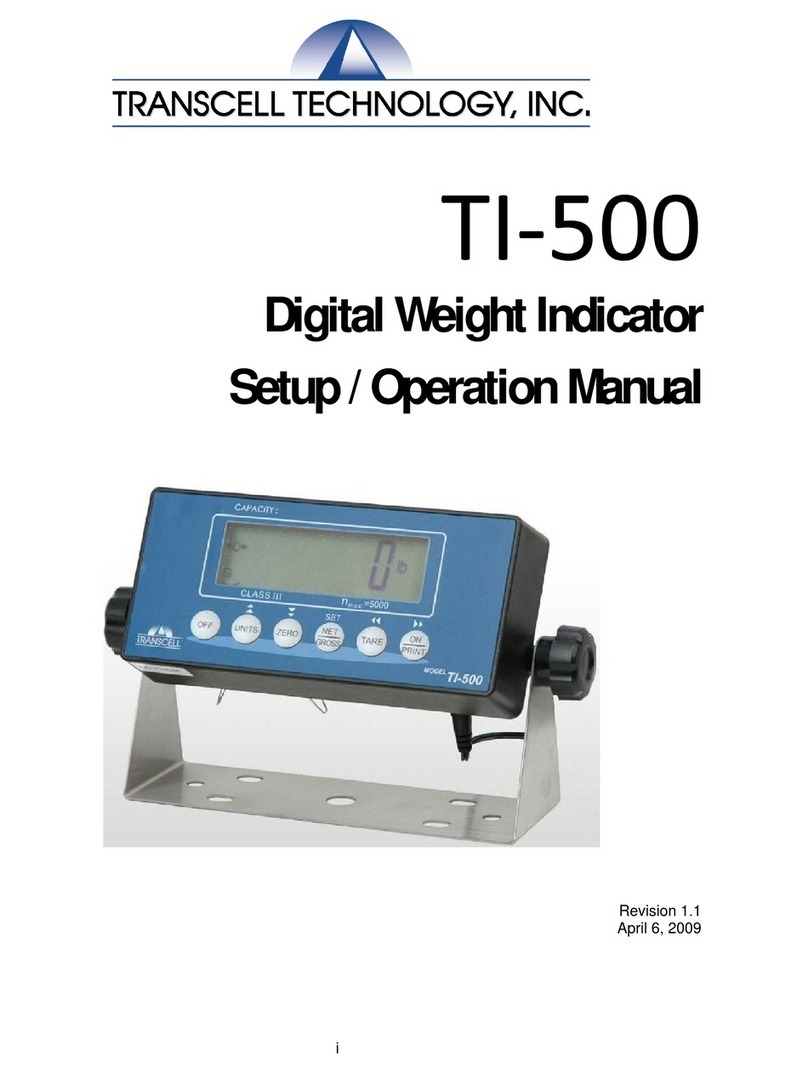
Transcell Technology
Transcell Technology TI-500 Parts list manual
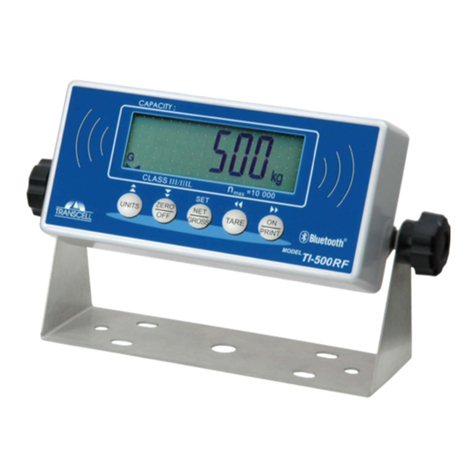
Transcell Technology
Transcell Technology TI-500 FDI Series User guide

Transcell Technology
Transcell Technology TI-500 User manual
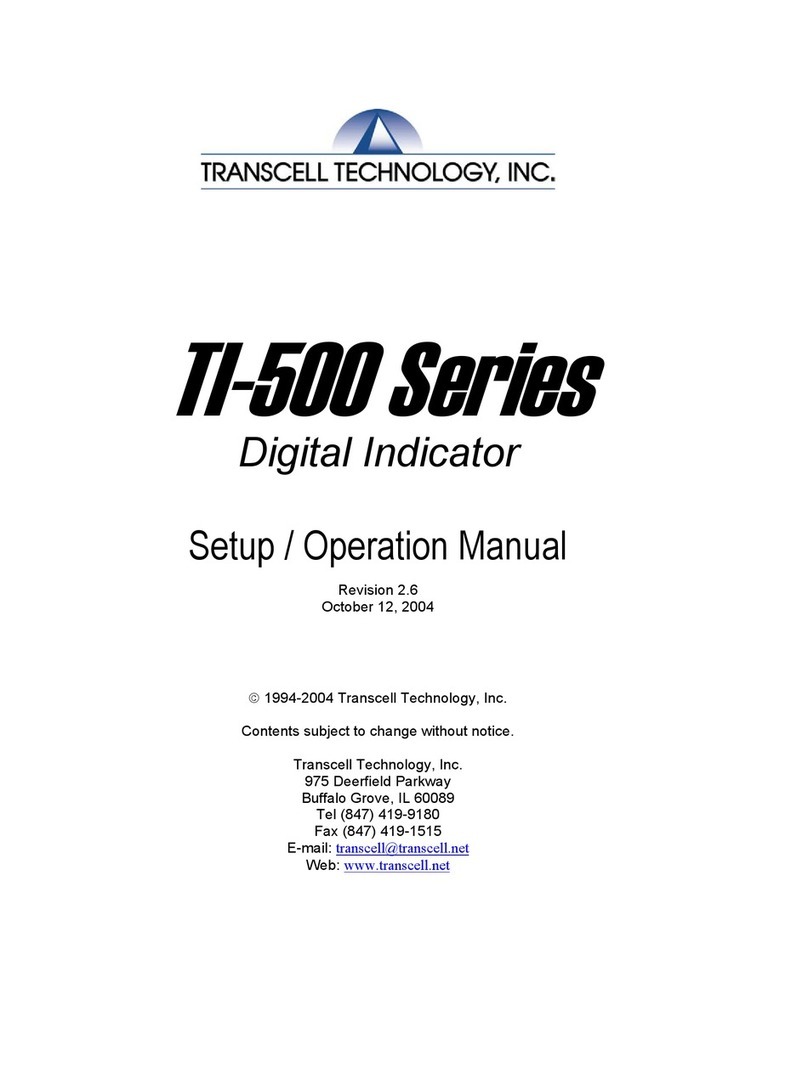
Transcell Technology
Transcell Technology TI-500E3 Parts list manual
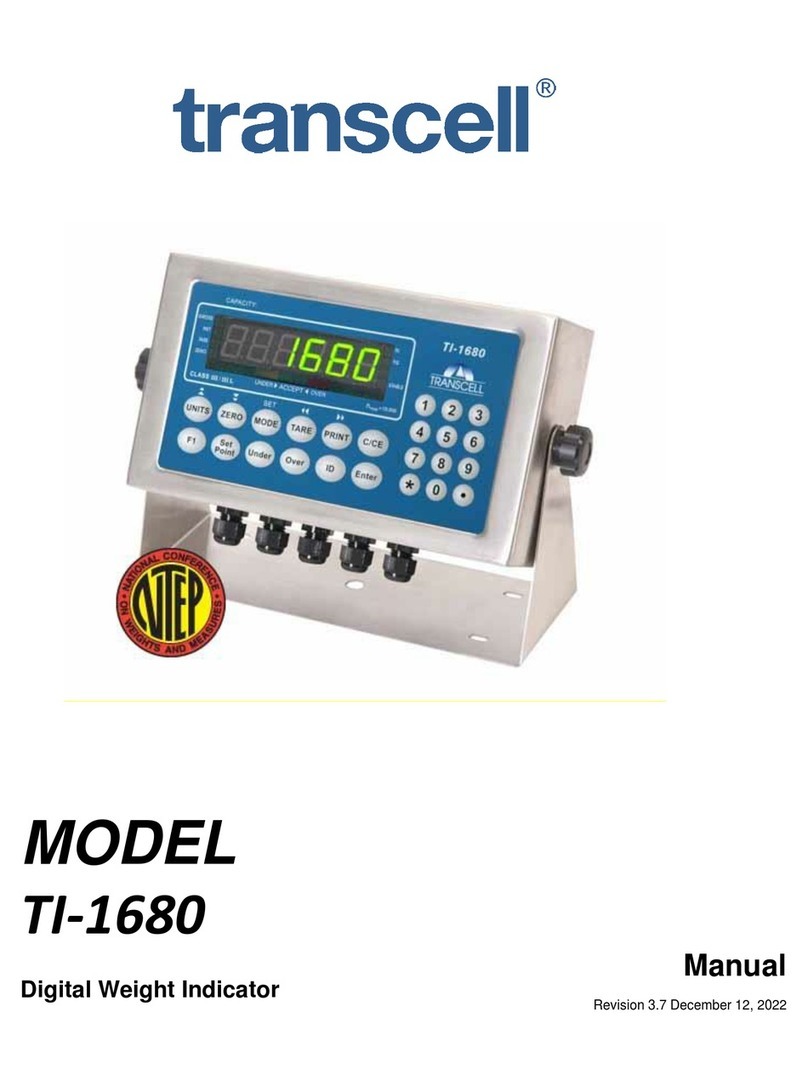
Transcell Technology
Transcell Technology TI-1680 User manual
Popular Measuring Instrument manuals by other brands
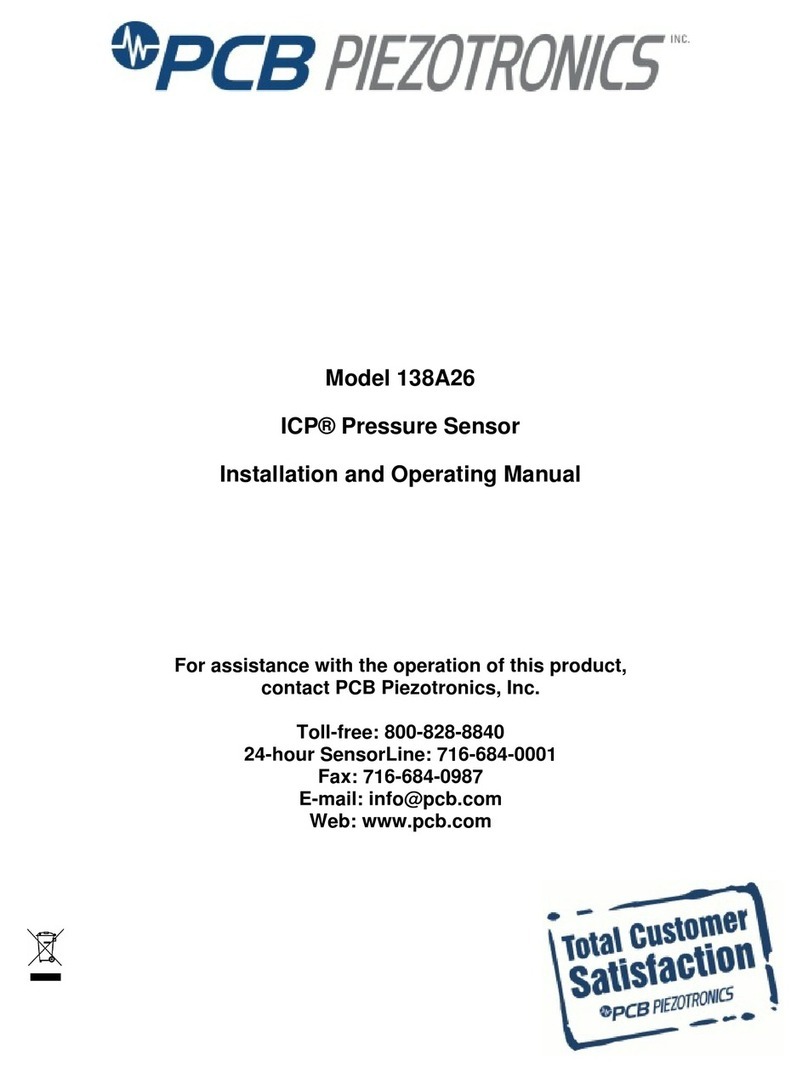
PCB Piezotronics
PCB Piezotronics 138A26 Installation and operating manual

Taylor
Taylor K-8000 user manual

H. HERMANN EHLERS
H. HERMANN EHLERS F010-P Operation manual

geo-FENNEL
geo-FENNEL FL 100HA Junior user manual
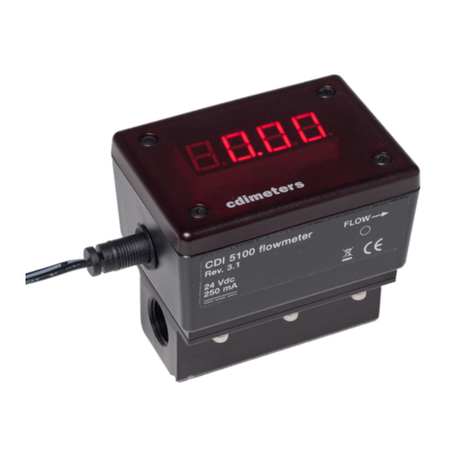
CDI Meters
CDI Meters CDI 5100 Installation and operating instructions
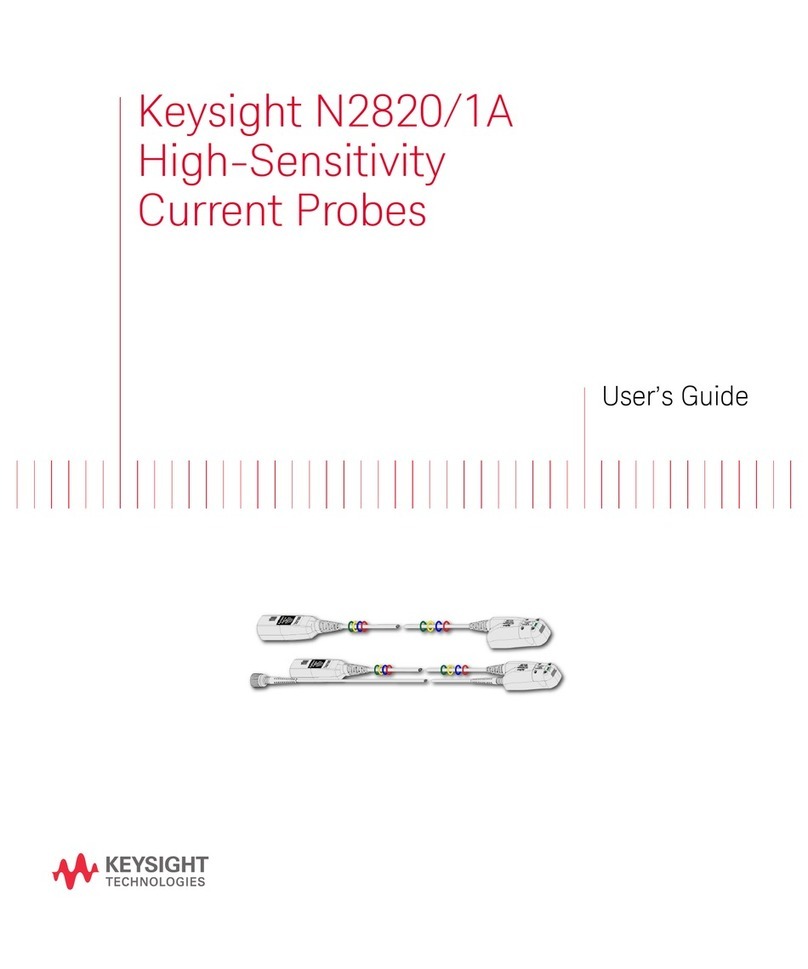
Keysight
Keysight N2820A user guide
